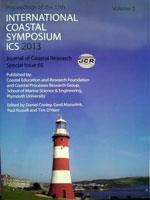Mole, M.A., Mortlock, T.R.C., Turner, I.L., Goodwin, I.D., Splinter, K.S. and Short, A.D., 2013. Capitalizing on the surfcam phenomenon: a pilot study in regional-scale shoreline and inshore wave monitoring utilizing existing camera infrastructure.
Driven by dynamic inshore wave climates, sandy beaches oscillate around long term mean trends at daily (storm events) to inter-annual timescales (regional climate cycles). Coastal imaging technology provides a practical means for sustained, autonomous beach morphology and inshore wave monitoring at high temporal resolution. However, existing, scientifically-proven systems are limited in their application due to cost and required infrastructure. A potential alternative has been identified in the existing surfcam networks operating at 100 sites around Australia and many sites around the world. This work reports a critical evaluation of this new, low-cost monitoring method which has the potential to significantly expand spatial coverage of coastal behavior; capturing both real-time forcing (waves) and effect (shoreline change). In this study, seven embayed beaches in New South Wales, Australia, are used to examine the potential for a sustainable regional monitoring network using existing surfcam infrastructure to provide daily measurements of shoreline position and inshore waves at the break point. Surfcam image-derived shorelines are compared at daily frequency over 10 months at one site to co-located Argus image-derived shorelines and at monthly frequency over 18 months at nine camera sites to concurrent on-ground RTK-GPS surveys. Preliminary comparisons to Argus image-derived and RTK-GPS surveyed shorelines indicated promising qualitative agreement. A simple geometric correction was shown to significantly improve the surfcam-derived shoreline measurements. Surfcam-derived inshore wave heights and periods are compared to three months of concurrent hourly nearshore (depth ~10m) wave buoy measurements at two camera sites. Initial evaluation of the wave measurement capability suggests a consistent over-estimation of smaller waves and under-estimation of larger waves. It is suggested that these “bottom-heavy” measurements are due to pixel rectification error associated with obliquity from a single low-angle camera; and the high variability in measurements due to beach and wave type.





